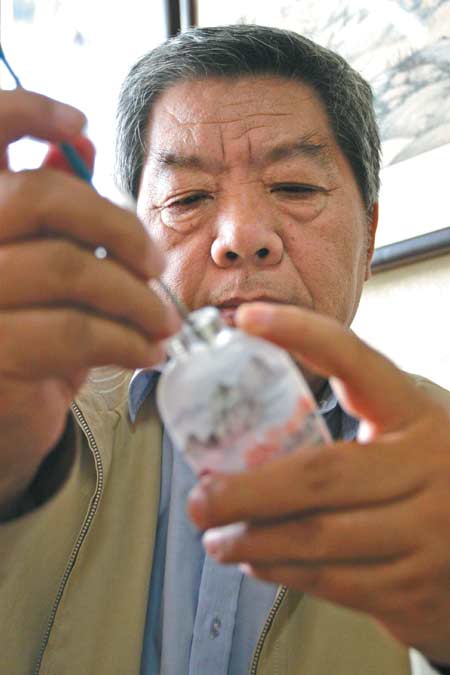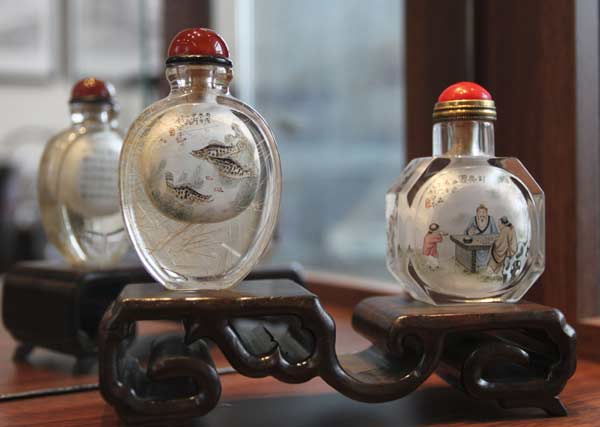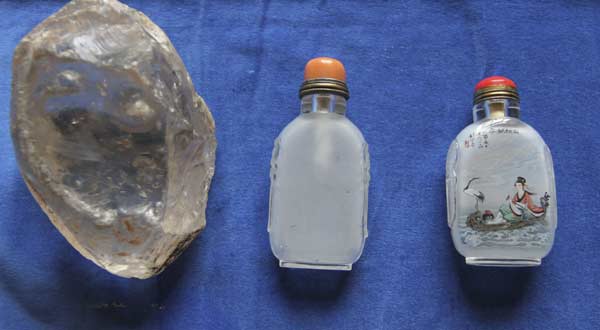Culture
Making sure ancient art stays up to snuff
By Wu Wencong (China Daily)
Updated: 2011-05-18 08:25
 |
Large Medium Small |
|
 Liu Shouben, a snuff bottle painter, says it takes at least two years to learn the craft and he would be delighted if more young people wanted to become apprentices. [PHOTO BY LIU ZHE / CHINA DAILY]
|
Related video: Art in a bottle
Every dynasty produced an art form that represented the peak of that era's creative work.
These included antefix tiles in the Han Dynasty, tri-colored glazed pottery in the Tang Dynasty and cloisonne enamelware in the Ming Dynasty. The most representative one for the Qing Dynasty was the snuff bottle with claborate-style paintings on its inner wall (neihua).
Snuff bottles are little boxes that hold high-quality powdered tobacco. Although smaller than the palm of an adult human hand, the bottles represent the highest mainstream aesthetic achievement of the Qing Dynasty (1644-1911).
It is said that when Emperor Jiaqing (1760-1820) asked his men to confiscate the property of Heshen, the infamously corrupt favorite of Emperor Qianlong, thousands of first-class snuff bottles were discovered, all of which Heshen had received as bribes.
"When snuff was first introduced to China in the 16th century, it was warmly welcomed by the rich and the noble, prompting artisans to improve the quality and exquisiteness of the little boxes that contained it," Liu Shouben, a craftsman with more than 50 years' experience of painting inside snuff bottles, told METRO.
At first, the bottles were not transparent. They were made of materials such as bamboo, wood, ivory, gold and jade. Glass was first used to make snuff bottles in 1696.
But there is no consensus on the history of painting inside snuff bottles. Liu's point is that the art developed out of "an inevitable accident".
He said clever craftsmen with a craving for tobacco would scrape the remains of the snuff inside the bottles with spoons. The random traces left by the snuff inspired a new art form.
Most of Liu's works are painted inside crystal snuff bottles.
"Snuff bottles were initially popular among the upper class," he said. "And the feeling of holding a piece of crystal when you're drawing is far better than holding glass."
A crystal snuff bottle is made from the mineral quartz. Craftsmen file it into the shape of a bottle, then punch a small hole in one end and empty the materials to get to the inner wall. The last step is to spray a layer of silicon carbide inside the bottle to make it rough, so that it is easier to draw on.
"I'd say the bottle itself is already a valuable artwork, even before painters like me start our work," said Liu. He explained one of the key characteristics of Beijing inside-bottle painting is that the craftsmen use only selected materials that are, in most cases, very expensive. The tools and dye used to finish the painting, on the other hand, are cheap and simple.
Sharpen one end of an ordinary prod, one used in a kebab would do, and roast it on the fire until the nib softens and bends to a certain angle. The dye is the same as that used in ordinary painting.
When the craftsman is drawing, spectators can barely see the movement of the tool, yet patterns start to appear.
"It is harder than drawing on a piece of paper; first, because it is tiny, and second, because you can only move your hand in a very small area as the mouth of the bottle is so small," Liu said. "But the good point is you can erase your mistakes quite easily."
Liu was introduced to the art form at the age of 17, in 1960, when he learned traditional Chinese painting and inside-bottle painting at the same time in a factory with several "classmates".
"There were no so-called talents or gifts. All of us had no background in it. It was like hopping on a random train. You ended up wherever it took you," Liu said.
The "train" used to send students to Liu regularly in the 1970s and 1980s, when he sometimes had as many as 40 apprentices. But the figure quickly dropped to four when the policy changed and no jobs were allocated to the young.
Liu said if the government does not come up with policies to support the art form, soon no one in Beijing will know how to practice the craft.
Liu's works sell for more than 20,000 yuan, and a basic crystal bottle sells for about 2,000 yuan.
Some bottles on the market cost only about 50 yuan but, Liu said, they are not fully hand-painted. Using photolithography, the lines of the paintings in the cheap bottles are copied, with the colors then filled in by hand.
Some of Liu's students have already become famous craftsmen in their own right. Yet Liu is still desperate to recruit more.
"I will be more than happy if young people come to me to learn the craft," he said. "But they'll have to stay with me for at least two years, not a few hours or a few days," he said.
(China Daily 05/18/2011 page)
| 分享按钮 |

